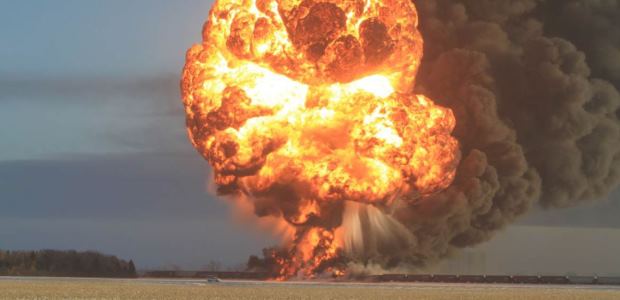
NTSB to Determine Cause of Casselton Accident Next Week
About 476,000 gallons of oil spilled from cars of a derailed BNSF train Dec. 30, 2013, and burned, forcing the evacuation of more than 1,400 residents of the town of Casselton.
The National Transportation Safety Board will meet Feb. 7 to determine the probable cause of the derailment of a BNSF train carrying crude oil in Casselton, N.D., on Dec. 30, 2013. The train struck a railcar filled with grain that had derailed from another BNSF train and blocked the track being used by the crude oil train; as a result, the two head-end locomotives and 21 cars of the crude oil train derailed.
About 476,000 gallons of oil spilled from those cars and burned, forcing the evacuation of more than 1,400 residents of the town of Casselton. No injuries to members of the public were reported. There were 104 cars in the crude oil train when it derailed; 18 of the cars that ruptured were general service DOT-111 tank cars, according to the NTSB Hazardous Materials Group Factual Report.
The meeting is set to begin at 9:30 a.m. Eastern time in the NTSB Board Room and Conference Center in Washington, D.C. A webcast of it will be available at http://ntsb.capitolconnection.org/ shortly before the start of the meeting.
The NTSB Hazardous Materials Group Factual Report, dated Oct. 8, 2014, and included in NTSB's docket on this investigation, indicates BNSF estimated damages at $6.1 million, not including environmental remediation costs.
NTSB investigators found a broken axle as they examined the wreckage, and NTSB determined that it fractured because of a void defect along its longitudinal center axis. NTSB also found there had been two other recent failures of axles from the same 2002 production run that also were caused by void defects. As a result, the Association of American Railroads issued a maintenance advisory to all member railroads in January 2014 requesting the inspection and removal of suspect axles.
(The photo illustrating this news story shows the fireball resulting from the derailment of 21 cars from a BNSF crude oil train in Casselton, N.D. It is included in the NTSB Hazardous Materials Group Factual Report. Photo courtesy of Dawn Faught.)